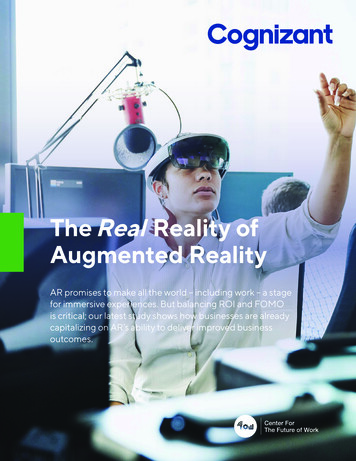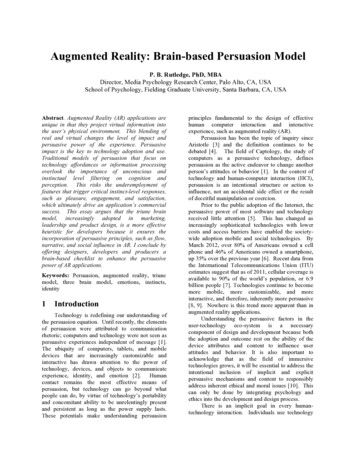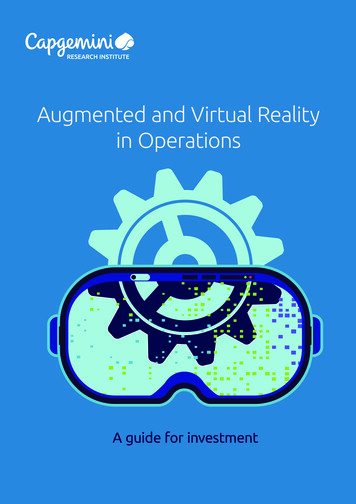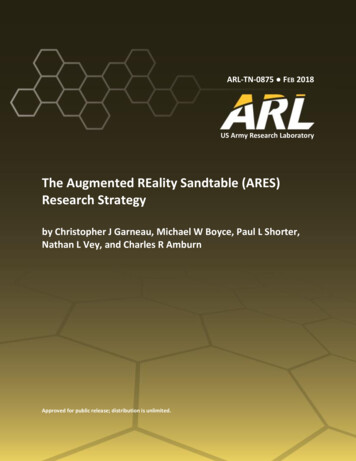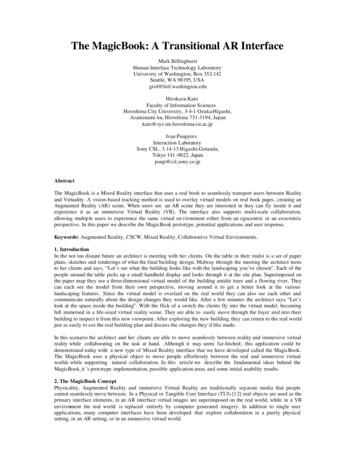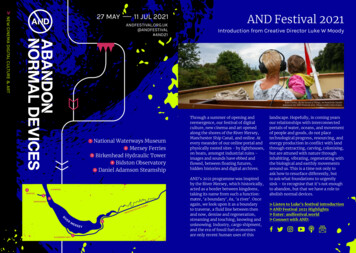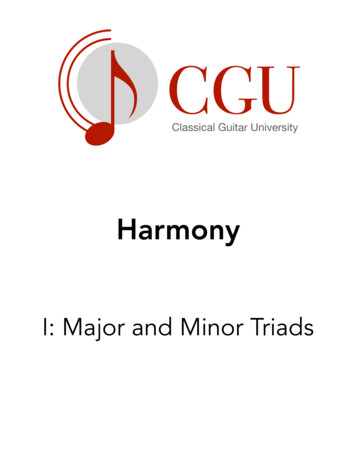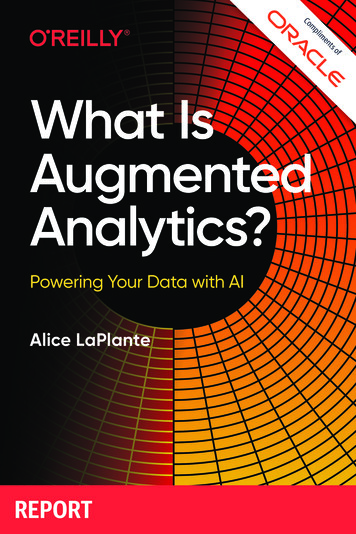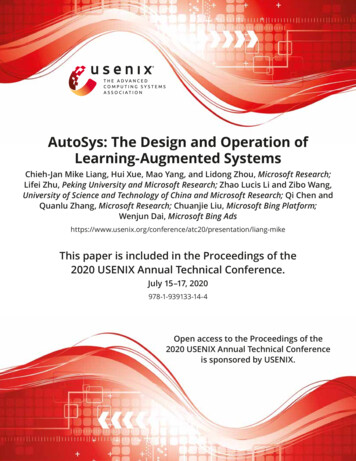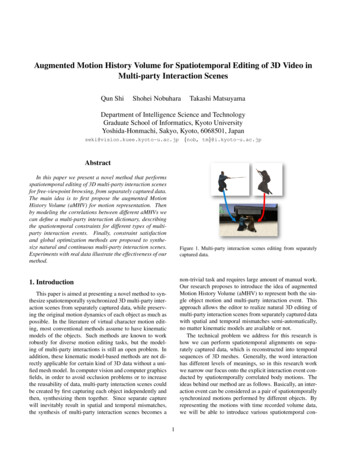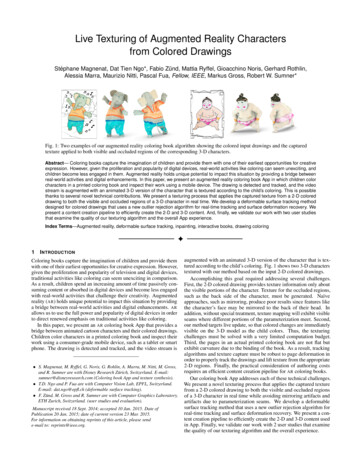
Transcription
Live Texturing of Augmented Reality Charactersfrom Colored DrawingsStéphane Magnenat, Dat Tien Ngo*, Fabio Zünd, Mattia Ryffel, Gioacchino Noris, Gerhard Rothlin,Alessia Marra, Maurizio Nitti, Pascal Fua, Fellow, IEEE, Markus Gross, Robert W. Sumner*Fig. 1: Two examples of our augmented reality coloring book algorithm showing the colored input drawings and the capturedtexture applied to both visible and occluded regions of the corresponding 3-D characters.Abstract— Coloring books capture the imagination of children and provide them with one of their earliest opportunities for creativeexpression. However, given the proliferation and popularity of digital devices, real-world activities like coloring can seem unexciting, andchildren become less engaged in them. Augmented reality holds unique potential to impact this situation by providing a bridge betweenreal-world activities and digital enhancements. In this paper, we present an augmented reality coloring book App in which children colorcharacters in a printed coloring book and inspect their work using a mobile device. The drawing is detected and tracked, and the videostream is augmented with an animated 3-D version of the character that is textured according to the child’s coloring. This is possiblethanks to several novel technical contributions. We present a texturing process that applies the captured texture from a 2-D coloreddrawing to both the visible and occluded regions of a 3-D character in real time. We develop a deformable surface tracking methoddesigned for colored drawings that uses a new outlier rejection algorithm for real-time tracking and surface deformation recovery. Wepresent a content creation pipeline to efficiently create the 2-D and 3-D content. And, finally, we validate our work with two user studiesthat examine the quality of our texturing algorithm and the overall App experience.Index Terms—Augmented reality, deformable surface tracking, inpainting, interactive books, drawing coloring1I NTRODUCTIONColoring books capture the imagination of children and provide themwith one of their earliest opportunities for creative expression. However,given the proliferation and popularity of television and digital devices,traditional activities like coloring can seem unexciting in comparison.As a result, children spend an increasing amount of time passively consuming content or absorbed in digital devices and become less engagedwith real-world activities that challenge their creativity. Augmentedreality (AR) holds unique potential to impact this situation by providinga bridge between real-world activities and digital enhancements. ARallows us to use the full power and popularity of digital devices in orderto direct renewed emphasis on traditional activities like coloring.In this paper, we present an AR coloring book App that provides abridge between animated cartoon characters and their colored drawings.Children color characters in a printed coloring book and inspect theirwork using a consumer-grade mobile device, such as a tablet or smartphone. The drawing is detected and tracked, and the video stream is S. Magnenat, M. Ryffel, G. Noris, G. Rohlin, A. Marra, M. Nitti, M. Gross,and R. Sumner are with Disney Research Zürich, Switzerland. E-mail:sumner@disneyresearch.com (Coloring book App and texture synthesis). T.D. Ngo and P. Fua are with Computer Vision Lab, EPFL, Switzerland.E-mail: dat.ngo@epfl.ch (deformable surface tracking). F. Zünd, M. Gross and R. Sumner are with Computer Graphics Laboratory,ETH Zurich, Switzerland. (user studies and evaluation).Manuscript received 18 Sept. 2014; accepted 10 Jan. 2015. Date ofPublication 20 Jan. 2015; date of current version 23 Mar. 2015.For information on obtaining reprints of this article, please sende-mail to: reprints@ieee.org.augmented with an animated 3-D version of the character that is textured according to the child’s coloring. Fig. 1 shows two 3-D characterstextured with our method based on the input 2-D colored drawings.Accomplishing this goal required addressing several challenges.First, the 2-D colored drawing provides texture information only aboutthe visible portions of the character. Texture for the occluded regions,such as the back side of the character, must be generated. Naı̈veapproaches, such as mirroring, produce poor results since features likethe character’s face may be mirrored to the back of their head. Inaddition, without special treatment, texture mapping will exhibit visibleseams where different portions of the parameterization meet. Second,our method targets live update, so that colored changes are immediatelyvisible on the 3-D model as the child colors. Thus, the texturingchallenges must be solved with a very limited computation budget.Third, the pages in an actual printed coloring book are not flat butexhibit curvature due to the binding of the book. As a result, trackingalgorithms and texture capture must be robust to page deformation inorder to properly track the drawings and lift texture from the appropriate2-D regions. Finally, the practical consideration of authoring costsrequires an efficient content creation pipeline for AR coloring books.Our coloring book App addresses each of these technical challenges.We present a novel texturing process that applies the captured texturefrom a 2-D colored drawing to both the visible and occluded regionsof a 3-D character in real time while avoiding mirroring artifacts andartifacts due to parameterization seams. We develop a deformablesurface tracking method that uses a new outlier rejection algorithm forreal-time tracking and surface deformation recovery. We present a content creation pipeline to efficiently create the 2-D and 3-D content usedin App. Finally, we validate our work with 2 user studies that examinethe quality of our texturing algorithm and the overall experience.
2R ELATED2.1ARWORKcreative tools for childrenA prominent early example of the combination of virtual content witha book is the MagicBook [4]. It uses large markers and virtual-realityglasses to view 3-D content based on which page of the book is open.The glasses are opaque and hence there is no blending of virtual contentwith any real content in the book itself. Scherrer and colleagues [34]have shown how well-integrated AR content can improve the userexperience of books, but the book itself is still a static element. Recently,Clark and Dünser [11] explore the use of colored drawings to textureAR elements. Their work uses a pop-up book metaphor, providinganimated augmented pop-ups that are textured using the drawing’scolors. Their paper also shows two 3-D models colored according tothe drawings, and a commercial product derived from this work calledcolAR1 shows many more. However, the paper does not include detailsof the texturing process. In addition to colAR, three other coloringbook products, Crayola Color Alive, Paint My Cat and Disney’s Colorand Play2 , use AR in the context of coloring. Although no details ofthe texturing process are provided, we suspect that these products usemanually-edited correspondences between triangles in UV space anddrawing space. The use case for these products targets line art printed athome, which avoids the issue of curved pages due to a book’s binding.For example, the colAR FAQ urges users to ensure that the printed pagesare “lying flat.” On the contrary, we support augmentation on deformedsurfaces and propose an efficient content creation pipeline that providesa mostly automatic method to generate appropriate UV mappings. Inaddition, we describe quantitative user studies which contribute to theanecdotal observations offered by Clark and Dünser [11].2.2Texture generation for 3-D meshesIn the context of our App, a 2-D colored drawing provides informationabout the texture of the portions of the 3-D model that are visible inthe drawing. Determining the texture for the occluded regions involvesfilling in the remaining portions of the model’s texture map, which is aninpainting problem. Inpainting addresses the task of filling a portion ofan image from other parts of the image. Methods can be split into twocategories: diffusion-based and patch-based [18]. The former consist ofpropagating local information around the boundary between the knownand the unknown parts of the image, under smoothness constraints.These methods work well for filling small unknown regions surroundedby known regions. However, they require many iterations and mayexhibit artifacts when filling larger regions [18]. Methods in the secondcategory copy patches from the known regions to the unknown onesuntil the unknown regions are filled completely. The order of fillingis critical for the visual result [13], but even the best filling order canlead to discrepancies, especially when an unknown region lies in themiddle of a known region [22]. Indeed, in that case there will likelybe non-matching patches in the center of the unknown region, creatingvisual artifacts. Recently, techniques such as graph cuts have beenapplied to alleviate this problem. The resulting algorithm producesgood visual results but takes about one minute for a typical image [22].Recent work on video inpainting [19] achieves real-time performance,but uses a desktop processor and fills only a small area of the image.A modern approach exploits the fact that local structures are typicallyrepeated in the image and therefore structural priors can be capturedand used for reconstruction [21]. These global methods work well forfilling many small holes, but are not designed to fill larger areas.Although these methods work well for image processing applications, they are not designed for real-time performance on mobile devices. In the context of texturing meshes from colored drawings, thecritical element is that the generated texture is continuous across silhouette boundaries and texture seams. Therefore, we express texturegeneration as a static problem whose aim is to create a mapping, forevery point of the texture, to a point in the drawing. Our proposed1 http://colarapp.com/2 http://www.paintmyzoo.com; algorithm is inspired by both diffusion-based and patch-based methods,as it both extends the known parts of the image to the unknown ones,and copies pixels know regions to unknown ones.2.3 Deformable surface trackingReconstructing the 3-D shape of a non-rigid surface from monocularimages is an under-constrained problem, even when a reference imageof the surface in its known rest shape is available. This is the problemwe address in the context of live texturing from colored drawings, asopposed to recovering the shape from sequences as in many recentmonocular Non-Rigid Structure from Motion methods such as [16, 17].Given correspondences between a reference image and a live inputimage, one can compute a 2-D warp between the images and infer a3-D shape from it, assuming the surface deforms isometrically [2, 10].The reconstruction has the potential to run in real time because it isdone in closed form and point-wise or by linear least-squares. However,the accuracy of the recovered shape is affected by the quality of the 2-Dwarp, which does not take into account the 3-D deformation propertiesof the surface. In our coloring book application, this problem is moresevere because a large part of the surface is homogeneously blank,making 2-D image warping imprecise.An alternative is to go directly from correspondences to a 3-D shapeby solving an ill-conditioned linear-system [31], which requires theintroduction of additional constraints to make it well-posed. The mostpopular added constraints involve preserving Euclidean or Geodesicdistances as the surface deforms, which is enforced either by solving aconvex optimization problem [8, 27, 32] or by solving sets of quadraticequations [33, 23] in closed form. The latter method is typically implemented by linearization, which results in very large systems and is nofaster than minimizing a convex objective function, as is done in [32].The complexity of the problem can be reduced using a dimensionality reduction technique such as principal component analysis (PCA)to create morphable models [12, 5], modal analysis [23], free formdeformations (FFD) [8], or 3-D warps [14]. One drawback of PCA andmodal analysis is that they require either training data or specific surface properties, neither of which may be forthcoming. Another is thatthe modal deformations are expressed with respect to a reference shape,which must be correctly positioned. This requires the introduction ofadditional rotation and translation parameters into the computation,preventing its use in live AR applications.The FFD approach [8] avoids these difficulties and relies on parameterizing the surface in terms of control points. However, its complexformulation is quite slow to optimize as reported in [7]. The work ofOstlund et al. [25] takes inspiration from the Laplacian formalism presented in [35] and the rotation-invariant formulation of [36] to derivea rotation-invariant regularization term and a linear subspace parameterization of mesh vertices with respect to some control vertices. Thistechnique leads to the first real-time 3-D deformable surface trackingsystem as reported in [24], which can run at 8–10 frames per second (FPS) on a MacBook Pro 2014 laptop. However, the high memoryconsumption and still heavy computation prohibit it from running inreal-time on mobile devices.To the best of our knowledge, there have been no reports so fardescribing a real-time deformable object tracking system on mobiledevices. The presented contribution is an improvement upon previouswork [24]. We propose a new outlier rejection mechanism, reformulatethe reconstruction energy function to gain speed while not sacrificingaccuracy, as well as rely on frame-to-frame tracking to gain framerate and only apply the feature detection and matching periodically toretrieve back lost tracked points and accumulate good correspondences.These together allow real-time tracking on a tablet.3P ROBLEMFORMULATIONOur method for live texturing an AR character from a colored drawingupdates the texture of the 3-D character at every frame by copying pixelsfrom the drawing. To do so, we create a UV lookup map, that, for everypixel of the texture, indicates a pixel coordinate in the drawing. As thedrawing lies on a deformable surface, the later procedure operates on arectified image of the drawing. We split this process into two separate
Content creation pipelinea3-D objectUV-mappedbCreation of seam andorientation mapscInitialisation of UV lookupmap with areas visible inthe projected drawingdorient. map Oseam map WFilling of L Ω, the parts of theUV lookup map L not visiblein projected drawingIsland map Iin UV mUV lookupmap Lin drawing spaceLive pipeline in mobile AppCameraimagegImage hprocessingTemplate iselectionSurfacetrackingjTexture kcreationAR mesh lrenderingAugmentedcolored meshlive from tabletFig. 2: The static content creation and the in-App live surface tracking, texturing, and rendering pipelines.pipelines, as shown in Fig. 2. A static content creation pipeline creates alookup map from the work of artists. This pipeline needs to be run onlyonce. A live pipeline tracks the drawing and overlays the augmentedcharacter on top of it, with a texture created from the drawing in realtime using the lookup map.3.1Content creation pipelineThis process aims at finding suitable lookup coordinates on the drawingfor the parts of the mesh that are not visible in the drawing, given aUV -mapped mesh and its projection as a drawing. We want to find alookup map that generates a texture that is continuous over the boundarybetween hidden and visible parts of the mesh in the drawing and overseams. We also want to fill hidden parts with patterns similar to theones on visible parts, with minimal distortions between them.3.1.1Production process and variables usedThe artist produces (1) a UV-mapped mesh (Fig. 2a); (2) an island mapI in UV space that defines regions that shall receive similar coloring(Fig. 2b); and (3) a drawing, which is a combination of a view ofthe mesh through an edge shader – for printing – and a mapping fromcoordinates on this drawing to points in the UV map (Fig. 2c).Based on these three items, the following objects are created: (1) thewrapping seams W i for island I i , mapping some pixels of I i together;(2) the orientation map O in the UV space, giving a local orientationof the projected mesh structure; and (3) the lookup map L, indicatingfor every pixel of the character texture which drawing pixel to read.L LΦ LΩ , where LΦ are regions visible in the drawing (sourceregions) and LΩ are regions not visible in the drawing (target regions).3.1.2Lookup map initialization and relaxationThe most-challenging part of the content creation pipeline is the creation of L, based on the mesh, the projected drawing, and the islandmap I. To do so, W , O (Fig. 2d), and LΦ (Fig. 2e) are first created. Then,i is generated by copyingfor every island I i , a first approximation of LΩicoordinates from LΦ . This approximation is very rough and violatesthe continuity desideratum, in particular across seams. Therefore, thenext step is to enforce this continuity (Fig. 2f).We can frame this problem in a similar way as the one of energyminimization in a spring system. Assuming that every pair of neighboring points of L – including across seams – are connected by a virtualspring, relaxing all springs will lead to fulfill the continuity constraints.To do so, we have to minimize the total energy of the system: k p,q ( L[q] L[p] 1)2(1)(p,q) NLfor all pairs p, q which are either direct neighbors or seam neighborsin L; k p,q being a constant specific to the pair (p, q) that compensatesthe texel density in the UV map, which is not constant compared tothe density in the model space. This correction is necessary for thegenerated texture motifs to be unstretched.3.2 Live pipelineGiven a set of colored drawing templates (Fig. 2c), the App takes thelive camera stream as the input (Fig. 2g), detects (Fig. 2i) and tracks(Fig. 2j) in 3D one of the templates appearing in the camera image. Inthis work, we explicitly account for the fact that the drawing paper maynot be flat and may change its shape during the coloring, which is acommon situation for books. Once the drawing shape is tracked in 3D,accurate color information from the colored drawing can be retrievedfor our texturing algorithm, unlike other existing works [11] that canonly deal with planar book pages. The augmented character is thenoverlaid on the input image by using the retrieved colors and the 3-Dpose of the drawing (Fig. 2m).3.2.1 Image processingGiven the camera image stream of the colored drawing, we want to process the input image so that the colored drawing appearance is as closeto the original template as possible (Fig. 2h). Our approach achievesthis by exploiting the fact that it is a line art drawing. This step isnecessary because the appearance of the drawing changes significantlydue to the coloring.3.2.2 Template selectionAfter the input image is processed to be close to the original line artdrawing templates, the system automatically detects which template isappearing in the camera stream (Fig. 2i). The selected drawing templateis used as the template image in our template-based deformable surfacetracking algorithm and later for drawing the augmented character.3.2.3 Deformable surface trackingAllowing the page to deform creates many challenges for the trackingalgorithm since the number of degrees of freedom in deformable surface tracking is much higher than that in rigid object tracking. Ourdeformable surface tracking (Fig. 2j) builds upon previous work [24]
and makes it fast enough to run in real time on mobile devices androbust enough to handle colored line art drawings. We will formulatethe shape reconstruction problem as shown in [24].We represent the drawing page by a pre-defined 3-D triangular meshwith vertex coordinates stacked in a vector of variables x [v1 ; . . . ; vNv ].The drawing page in its rest shape corresponds to the triangular meshin the flat rectangular configuration with the paper size as dimensions.To make the template appear similar to the one captured by the camera,we synthetically render a reference image in the camera view in whichthe template image occupies 2/3 of the camera view.To reduce the problem dimension, instead of solving for all meshvertex coordinates, we use a linear subspace parameterization thatexpresses all vertex coordinates as a linear combinations of a smallnumber Nc of control vertices, whose coordinates are c [vi1 ; . . . ; viNc ],as demonstrated in a previous work [25]. There exists a linear relationx Pc, where P is a constant parameterization matrix.Given point correspondences between the reference image generatedabove and an input image, recovering the colored drawing shape in thisimage amounts to solving a very compact linear systemminckMPck2 w2r kAPck2 , s.t. kck 1 ,(2)in which the first term enforces the re-projection of the 3-D reconstructed mesh to match the input image data encoded by matrix M, thesecond term regularizes the mesh to encourage physically plausible deformations encoded by matrix A, and wr is a scalar coefficient defininghow much we regularize the solution. This linear system can be solvedin the least-square sense up to a scale factor by finding the eigenvectorcorresponding to the smallest eigenvalue of the matrix MTwr Mwr , inwhich Mwr [MP; wr AP]. Its solution is a mesh whose projection isvery accurate but whose 3-D shape may not because the regularizationterm does not penalize affine deformations away from the referenceshape. The initial shape is further refined in a constrained optimizationthat enforces the surface to be inextensiblemin kMPck2 w2r kAPck2 , s.t. C (Pc) 0 ,c(3)giving the final 3-D pose of the drawing in the camera view. C(Pc)are inextensibility constraints that prevent Euclidean distances betweenneighboring vertices from growing beyond their geodesic distance inthe reference shape.3.2.4 Texture creation and mesh renderingOnce the 3-D shape of the colored drawing has been recovered inthe view of camera, the mesh is re-projected onto the image plane.This re-projection defines a direct mapping between the pixels on theoriginal drawing template and the pixels on the image of the coloreddrawing. We then can generate the texture for the character mesh usingthe lookup map L (Fig. 2k). Using the live view as the backgroundimage for the 3-D scene, and using proper parameters for the virtualcamera, we can render the augmented character in the 3-D pose of thepage using the generated texture from the drawing (Fig. 2l).In Sec. 4.2, we will present in detail how we tackle the steps described above and compare to [24] our improved method to achieve arobust, accurate, and real-time tracking system for colored drawings.4 I MPLEMENTATION4.1 Generation of the UV lookup map L4.1.1 Initialization of visible parts of the UV lookup mapTo create the visible part LΦ of the UV lookup map:1. An artist prepares the texture-mapped mesh and the island mapI. Each island has a unique color, unused boundary pixels aremarked as well.2. An optional mask can be used to exclude some pixels of LΦ . Thisallows, for example, ignoring the printed black outlines in thecoloring book. The artist is responsible for deciding which pixelsto exclude.3. A unique color UV texture is generated, in which every pixel hasa color that encodes its position.4. The mesh is rendered using the unique color texture, producingan image where each pixel encodes the UV position that was usedto create it.5. LΦ is computed by traversing each pixel in the rendered image,computing its position in the UV space, and recording its destination at that location.4.1.2Creation of the seam mapThe seam map W is created from the input mesh and the island map I.The resulting seams describe which points in the UV space correspondto the same points on the mesh. Only seams within a UV island areconsidered.1. The mesh is transformed into a graph in UV space; each vertex ismapped to one or more nodes having exactly one UV coordinateand an island index.2. All sets of nodes that correspond to the same vertex are addedto a candidate set. Edges connecting nodes that are part of thecandidate set are added to the graph.3. A set of pairs of seams is extracted by traversing these edgesstarting at the candidate points, while ensuring that a seam pairconsists of corresponding nodes and has the same topology.4. Seam edges are rasterized so that not only vertices, but all pointson seams are linked together in W .4.1.3Creation of the orientation mapThe orientation map O encodes a locally-consistent orientation derivedfrom the edges of the input mesh in UV space.1. The mesh is transformed into a graph in UV space, where eachvertex is mapped to one or more nodes.2. For each node, we normalize the directions of connecting edgesand cluster them into direction groups. If there are two clusters,we store the average directions, otherwise we ignore the node.3. The orientation is made consistent by traversing the graph and byrotating the directions of nodes.4. The projected mesh in UV space is rasterized to assign to eachpixel the orientation of the nodes of the corresponding face.4.1.4Creation of an initial complete UV lookup mapThe algorithm for creating an initial lookup map is shown in Algorithm 1. It takes a two-step approach. First, it creates an initial mappingby copying coordinates from the known region (source) into the unknown one (target) in a way that maintains continuity constraints atthe border between these regions. Second, it removes discontinuities atseams by expressing neighboring constraints as a spring system, whosetotal energy must be minimized.The creation of the initial mapping works by copying coordinatesfrom one side of the border to the other side. The algorithm first propagates a gradient from the border of the source region into the targetregion. The generation of that gradient uses the E* algorithm [28],which is a variation of A* on a grid with interpolation. Then, startingfrom points close to the source, for every point in the target the algorithm counts the distance to the source, by tracing a path followingthe gradient. Once in the source, the algorithm continues to trace thepath in the already-mapped area until it has run for the same distanceas it did in the target. If the tracing procedure encounters the end ofthe already-mapped area, it reverses the orientation of the path. Thisprocedure leads to rough copies of the source area being written intothe target area.Algorithm 1 shows the most common execution path. In addition tothis normal path, the island I and the mesh can be arbitrarily pathological: some areas in Ω might be unconnected to Φ or there can be saddlepoints in the gradient. Therefore, the algorithm needs a procedureto recover from exception cases; this is represented by F IX B ROKEN P OINTS (). While iterating over points in Ω, the algorithm collectsall points that fail to reach a valid point in Φ, and stores by island ithem for further processing. Then, for every of them it checks whetherone of its neighbor is valid, and if so, it copies its mapping. For theremaining points, which typically belong to unconnected regions inΩi , it groups them in connected blobs and tries to copy a consistent
Algorithm 1 The initial creation of the lookup map1: procedure G ENERATE L OOKUP(I,LΦ ,W ,O)2: First approximation3:L 0/4:for i in enumerate(I) do5:G generate gradient for island ii initialize with source6:Li LΦ7:for p in sorted(Ωi , G) do for points in target8:d, p′ 0, pi do until source reached9:while p′ / LΦ′10:p descend G from p′11:d d 1 count distance in target12:end while13:v incoming direction enter source14:while d 0 do trace same dist. as in target15:if p′ / Li then unknown mapping16:v v reverse direction17:else18:Li [p] Li [p′ ] copy mapping19:end if20:rotate v using O[p′ ] follow source orientation21:p′ , d p′ v, d 122:end while23:end for24:L L Li merge lookup for this island25:end for26:F IX B ROKEN P OINTS ()27: Relaxation28:e iterative relaxation29:for c in range(cmax ) do30:L, e′ R ELAX L OOKUP(L,W )31:if e′ e then if error increases. . .32:break . . . stop early33:end if34:e e′35:end for36:return L37: end proceduremapping based on the center of the largest region in Φi . If some pixelscannot be copied, the algorithm assigns a point from Φi .The algorithm then solves Eq. 1 by performing iterative relaxation.For each point, it attaches a spring to its neighbors (4-connectivity)and, if this point is on a seam, to the point on the other side of theseam (using the seam map W ). The spring constant is adjusted toaccount for the distortion in the UV map. The algorithm iterativelyrelaxes all springs, using a simple iterative gradient descent method.The relaxation stops if the error does not diminish for a continuousnumber of steps. In our experiments, we set this number to 8; we setthe maximum number of iterations cmax to 100,000 but the algorithmtypically stops early after 4,000–20,000 steps.4.2Deformable surface trackingIn this section, we describe our algorithm to detect and track in 3Da possibly non-flat deformable colored line drawing paper. We relyon wide-baseline feature point correspondences between the referenceimage and the input image. For this, we propose to use BRISK [20] inplace of the memory-intensive Ferns [26] used in [24]. Since many ofthe correspondences are erroneous, we propose a new outlier rejectionalgorithm, which is faster and more robust than the one used in [24].We reformulate the reconstruction energy function to gai
In this paper, we present an augmented reality coloring book App in which children color characters in a printed coloring book and inspect their work using a mobile device. The drawing is detected and tracked, and the video stream is augmented with an animated 3-D version of the character that is tex
